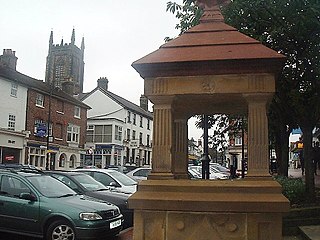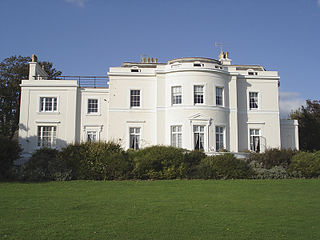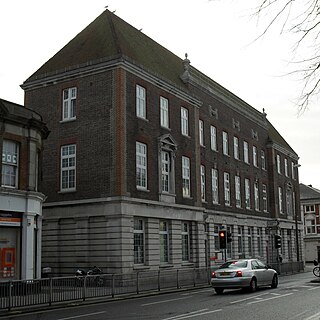
Sir Alan Ayckbourn is a prolific British playwright and director. He has written and produced as of 2023, 89 full-length plays in Scarborough and London and was, between 1972 and 2009, the artistic director of the Stephen Joseph Theatre in Scarborough, where all but four of his plays have received their first performance. More than 40 have subsequently been produced in the West End, at the Royal National Theatre or by the Royal Shakespeare Company since his first hit Relatively Speaking opened at the Duke of York's Theatre in 1967.

East Grinstead is a town in West Sussex, England, near the East Sussex, Surrey, and Kent borders, 27 miles (43 km) south of London, 21 miles (34 km) northeast of Brighton, and 38 miles (61 km) northeast of the county town of Chichester. Situated in the extreme northeast of the county, the civil parish has an area of 2,443.45 hectares. The population at the 2011 Census was 26,383.

Worthing is a seaside resort town in West Sussex, England, at the foot of the South Downs, 11 miles (18 km) west of Brighton, and 18 miles (29 km) east of Chichester. With a population of 113,094 and an area of 12.5 square miles (32.4 km2), the borough is the second largest component of the Brighton and Hove built-up area, the 15th most populous urban area in the United Kingdom. Since 2010, northern parts of the borough, including the Worthing Downland Estate, have formed part of the South Downs National Park. In 2019, the Art Deco Worthing Pier was dubbed the best in Britain.

Robert Cecil Romer Maugham, 2nd Viscount Maugham, known as Robin Maugham, was a British author.

The Playhouse Theatre was a theatre in central Perth, Western Australia. It was purpose-built for live theatre in 1956 and remained one of the city's principal venues for performing arts for over half a century until replaced by the State Theatre Centre of Western Australia in January 2011. It was home to the National Theatre Company from its establishment until 1984, and then to its successor, the Western Australian Theatre Company, until its disbandment in 1990.

The Dome Cinema, Worthing, West Sussex, England, is a grade II* listed building owned by PDJ Cinemas Ltd. The Dome Cinema, which has three screens and a Projectionist's Bar is run by PDJ Cinemas, while Alfresco Services run two function rooms and the cafe at the front of the building. It has closed for refurbishment several times, most recently between December 2005 and July 2007. The name derives from the distinctive dome on top of a three-storey tower over the entrance.
Carl Adolf Seebold (1873–1951) was a Swiss impresario who commissioned and ran the Dome Cinema in the English coastal town of Worthing in West Sussex.
Worthing, a seaside town with borough status in the United Kingdom, is connected to the rest of the country by a network of major roads, a mainline railway, frequent bus and coach services and a nearby airport. Its 19th-century growth was encouraged by the development of turnpikes and stagecoach routes to London and nearby towns. By the middle of that century railway services improved journey times and conditions significantly. Suburbanisation in the 20th century was assisted by a network of bus routes.

Worthing, a town with borough status in the English county of West Sussex, has 212 buildings with listed status. The Borough of Worthing covers an area of 8,030 acres (3,250 ha) on the south coast of England, facing the English Channel. The town's development in the early 19th century coincided with nearby Brighton's rise as a famous, fashionable resort, and Worthing became a quiet seaside town with a large stock of Victorian buildings. Residential growth in the 20th century absorbed nearby villages, and older houses, churches and mansions became part of the borough. The Town and Country Planning Act 1947, an act of Parliament effective from 1948, introduced the concept of "listing" buildings of architectural and historical interest, and Worthing Borough Council nominated 90 buildings at that time. More have since been added, but others have been demolished. As of 2009, Worthing has three buildings of Grade I status, 11 listed at Grade II*, 196 of Grade II status and three at the equivalent Grade C.

Worthing, a seaside town in the English county of West Sussex which has had borough status since 1890, has a wide range of public services funded by national government, West Sussex County Council, Worthing Borough Council and other public-sector bodies. Revenue to fund these services comes principally from Council Tax.

Worthing Tabernacle is an independent Evangelical Christian church in the town and borough of Worthing, one of seven local government districts in the English county of West Sussex. The present building, with its distinctive pale stone exterior and large rose window, dates from 1908, but the church was founded in 1895 in a chapel built much earlier in the 19th century during a period when the new seaside resort's population was growing rapidly. In its present form, the church is affiliated with the Fellowship of Independent Evangelical Churches. English Heritage has listed the building at Grade II for its architectural and historical importance.

Beach House Park is a formal garden in Worthing, a town and local government district in West Sussex, England. Opened by Worthing Borough Council in 1924, the 9.57-acre (3.87 ha) park has formal lawns and flowerbeds, bowling greens of international standard, and a war memorial commemorating war pigeons. A café in the grounds was destroyed by fire in 2009.

Royal & Derngate is a theatre complex in the Cultural Quarter of Northampton, England, consisting of the Royal Theatre, Derngate Theatre and the Northampton Filmhouse.
Stephen Joseph was an English stage director and pioneer of "theatre in the round."

The Coronet Theatre, formerly The Print Room, is an Off West End theatre located in the former Coronet Cinema in London. The building originated as a theatre in 1898; the modern company was founded in Westbourne Grove, West London, and opened in September 2010. It produces a programme of theatre, art, dance, poetry, film and music. The theatre is run by Artistic Director Anda Winters.

The Minerva Theatre was a theatre located in Orwell Street in Kings Cross, Sydney. Originally a live venue, it was converted to the Metro Cinema in 1950, before returning to live shows in 1969. It ceased operating as a theatre in 1979. The Metro Minerva Theatre Action Group (MTAG) formed in 2019 is lobbying for its reinstatement.
Dorothy Edwards was a Welsh actress who worked in television, radio, and theatre from the late 1930s through the late 1970s. She is best remembered for portraying Mrs. Oakley in the first season of Crossroads in 1964, and for the role of Nancy in the mini-series The Owl Service between 1969 and 1970. She also had lengthy stints on BBC radio portraying Mrs Dixon in Waggoners' Walk and Mrs. Manning in Mrs Dale's Diary. She had a close association with the Castle Theatre, Farnham at which she appeared in more than 200 parts. She was a founding member of the Redgrave Theatre, Farnham.

The following is a timeline of the history of the borough of Worthing, West Sussex, England.















